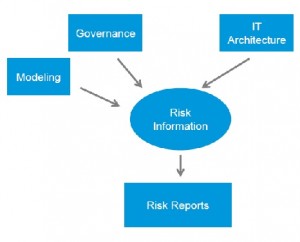“It’s a quality piece of work that lays out the road ahead,” said Donna Howe, professor of finance at Brandeis International Business School. She was the first of two speakers at a webinar to discuss the 2013 Basel paper, Principles for Effective Aggregation and Reporting of Risk Data. The webinar was sponsored by the Global Association of Risk Professionals.
Besides governance, Howe noted the 14 principles described in the paper expressed four main themes: completeness, accuracy, timeliness, and adaptability.
Completeness of risk reporting is necessary, but “it becomes very easy to lose the nuance” when the data are too numerous or two detailed, Howe said. Hundreds of data points on key performance indicators can overwhelm the decision-makers.
Completeness implies all types of risk must be taken into account. It can be challenging to combine different risk types, Howe said. New issues are surfacing, for example, with respect to reputational risk—is it a real risk, or just an outcome of operational risk?
Good risk management requires both current and forward-looking risk data. “We want to look at forward risk curves for different time slices,” Howe said.
Accuracy is desirable, Howe said, but should not be confused with precision. “I have concerns that the search for precision will use more resources than warranted,” she said. For starters, a risk group should focus on determining the bounds of the exposures, and understanding the trigger events, she suggested.
Timeliness should be understood in the context of how quickly a certain risk profile changes. Howe said she had observed a tendency to shrink the time interval—from annual to quarterly to monthly to daily—without asking how significant it would be for the decision-making cycle. “Don’t just produce more data without enhancing the decision making,” she said.
Adaptability involves converting or adapting standard reporting into special case or “ad hoc” reports. To adapt properly, a risk group needs to understand the requirements and tie into the appropriate technology where possible. Howe suggested trying to build ad hoc reports from the standard template. The risk group might find, for example, that new data fields must be added in the IT design or the model must start with different assumptions.
One item missing from the BIS paper, Howe remarked, was mention of the intersection of risks. For example, every time a counterparty fails, there is a combination of market, credit, and liquidity risks all at once. In response to a question from the audience about the diversification benefit, she said that for now the risks are assumed additive, in a “perfect storm” scenario.
Howe suggested that optimizing the reporting process could lead to reporting innovations. “For instance, in the future we may have materiality curves–what is a material risk threshold for the next week may not be material at the same level six quarters forward.” ª
The webinar presentation can be found at: http://event.on24.com/r.htm?e=699796&s=1&k=749171F66E3E96E3CD5FC6549BB83B0F


